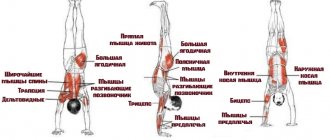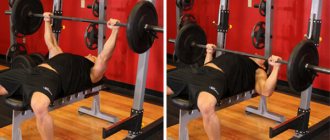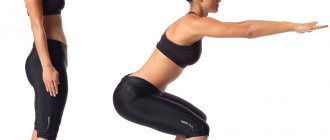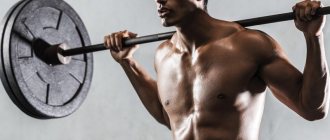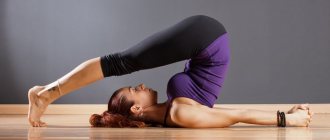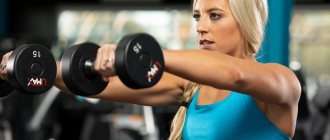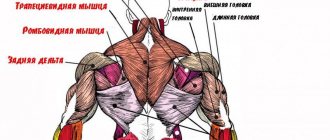The 7 shoulder training programs given in the article will help you figure out what exercises you can do to pump up your deltoids. Each set of shoulder exercises will help pump up the entire shoulder girdle and work out all the deltoid muscle bundles and separately, the middle, anterior and posterior ones.
- How to pump up your shoulders
- How to build big shoulders: training for mass Shoulder training program for mass
- Shoulder training for relief
- Training program
- A set of exercises for the middle deltoids
- A set of exercises for the rear deltoids
- A set of exercises for the front deltoids
How to pump up your shoulders
There are no two people who would train exactly the same way and build big shoulders. Each athlete performs a different sequence of exercises, number of approaches, uses different weights and length of rest periods. This article will help everyone figure out how to pump up their shoulders in the gym or at home.
Individuality is an inherent property of a person, and there is nothing wrong with that, but it imposes restrictions on how to pump up the deltoid muscles for an individual person. Certain principles and approaches make training better, especially when it comes to the question of how to quickly pump up your shoulders. Therefore, I have compiled 7 really effective sets of shoulder exercises, each of which will tell you how to pump your shoulders for relief, width and mass.
Please note that the order of exercises, weights, number of repetitions and volume can be changed to find the best way for you to pump up the deltoid muscles. Once you choose a workout that works for you, follow it for 4-8 weeks and then return to your usual routine or try another one from this list.
Notes:
- Below we will mainly talk about how to pump up your shoulders in the gym, but some of the programs are well suited for training at home.
- The given sets of exercises do not include warm-up. When warming up, perform as many reps as you need, but never reach muscle failure.
- Choose a weight that will allow you to reach muscle failure in the prescribed number of repetitions. This will be the correct pumping of the shoulders in order to involve the maximum number of delta muscle fibers in the work and achieve muscle growth.
- If you're training with a partner, do a few forced reps on your heaviest set of overhead presses. If not, then perform a drop set on the last set of each exercise, reducing the weight by about 25% when muscle failure is reached. In total it needs to be achieved 2 times.
Rules for performing shoulder exercises
To prevent injuries to muscles and joints, any set of exercises, including exercises for the shoulders, begins with a good warm-up. At home, warm-up is very important, because improves blood circulation and optimizes the load on the heart during exercise. This is important because without the preparatory stage, fainting may occur.
In addition, a good warm-up mentally prepares the trainee for the main set of exercises.
Steps to a good warm-up:
- Light cardio will increase heat transfer, warm up the muscles, and prepare them for further stretching.
- Joint exercises will improve joint mobility and activate the ligamentous apparatus.
- Dynamic stretching – will increase muscle elasticity and reduce the risk of tendon ruptures.
While performing the main complex, it is necessary to monitor your posture - you cannot lean forward, otherwise the load on the muscles of the neck, shoulders and back will be distributed unevenly.
How to build big shoulders: mass training
Goal: building up all the deltoids
The most effective method for pumping up your shoulders in the gym is to work with heavy weights, but you need to approach the training correctly so as not to get injured. To do this, you need to warm up well and follow the exercise technique.
To build shoulder mass, always start your workout with the most difficult exercises (in this case, overhead presses) that allow you to lift more weight. Then perform single-joint exercises on each of the three deltoids: anterior, middle, and posterior. This will set the stage for muscle building work as long as you maintain your overall training volume.
When we pump our shoulders, we can complicate the training in several ways. For the overhead press, start by using dumbbells, which are notoriously more difficult to balance and allow for a greater range of motion than a barbell. You'll also do the reverse pyramid because it gives you the opportunity to do more sets with muscle failure. For the first 2 sets, you'll use fairly heavy weights in a low rep range (6) to build strength. As fatigue accumulates in subsequent approaches, reduce the weight by about 5 kg. Perform the last 2 heaviest approaches with a belay partner so that you can maintain technique.
Because the front delts do a lot of the work in chest training, and the middle delts bear the brunt of the weight during the overhead press, the rear delts often remain small and weak. In this workout, shoulder pumping takes place when you have a lot of strength in reserve. At the same time, don't be afraid to change the order of single-joint exercises based on your weaknesses. If you think that all of your deltoids are proportionally developed, simply perform these exercises in a different order at each workout.
Massive shoulder training program
- Dumbbell overhead press - 4 sets of 6,6,8,10 reps (2 minutes rest)
- Barbell rows to the chin - 3 sets of 8,8,10 reps (2 minutes rest)
- Bent-over dumbbell raises - 3 sets of 8, 10, 12 reps (1 minute rest)
- Standing dumbbell lateral raises - 3 sets of 8,10,12 reps (1 minute rest)
- Lifting the barbell overhead with straight arms - 3 sets of 8,10,12 reps (1 minute rest)
Basic exercises
We bring to your attention several of the most effective basic shoulder exercises so that you can choose the most suitable ones for yourself. It is better to do the first few workouts with an instructor so that he can control you, explain and show you the technique.
Also, do not forget about isolation exercises - most movements for the middle and posterior bundles are exactly like this, but this does not mean that they are ineffective. You just need to competently combine base and isolation depending on your goals, length of service and training experience.
Barbell chest press standing and sitting
The standing chest press is also called the military press. This is the most effective exercise for developing the pushing function of the deltoid muscle.
And that's why:
- Free weight exercises work a lot of stabilizer muscles.
- Large range of motion: you can touch the barbell to your chest, you can lower it to your chin if you feel uncomfortable doing it too low.
- The exercise can be done by any person, not just weightlifters. It is enough to choose a comfortable weight.
Advice! The grip on the bar for this exercise should not be too wide or too narrow. Optimal option: slightly wider than shoulder width. The forearms in the starting position should be perpendicular to the floor. When lifting the barbell, do not follow it with your eyes. Don't extend your elbows all the way - this is true for all shoulder presses.
The exercise can also be done while sitting:
© Makatserchyk — stock.adobe.com
Many people think that this will reduce the load on the spine, but in fact the opposite is true - the load on the intervertebral discs in this movement will be greater in a sitting position. And if for small weights there is not much difference, and you can start doing the exercise while sitting, and then switch to the standing version, which is more difficult in terms of technique, then with large weights you should definitely work only in a standing position.
Another option is to sit in Smith. Here the movement will be strictly specified by the design of the simulator, which “turns off” some of the stabilizer muscles and makes the bench press itself a little easier. That's why the weights here will be a little higher. However, a given vector of movement can also be a problem - the risk of injury to the shoulder joints increases, since here you will not be able to move the projectile in the plane of the floor, only perpendicular to it.
© Makatserchyk — stock.adobe.com
Bench press standing and sitting
In this exercise you will take less weight than in the previous version, although the amplitude here is obviously shorter. But the shoulder joints have less freedom, which increases the risk of injury. In addition, you need to lower the projectile behind your head more slowly and under control - you can accidentally hit the back of your head.
Lift the barbell straight up from behind your head, in the same plane as your forearms. Leaning forward may cause you to fall and drop the projectile on your neck. And if you lean back, you can injure your shoulder joints. It is better to do this exercise in front of a mirror or with an instructor.
A similar exercise can be performed while sitting (including in Smith), but for this, as in the previous exercise, you need to have a pumped lower back and a healthy spine. It is also more difficult to throw the projectile in a sitting position. While standing, you can step back and forward to adjust your balance.
© Makatserchyk — stock.adobe.com
Many people believe that the exercise is aimed at developing the middle deltoids. They really work, but the front ones still take on more load. This is why all pressing exercises should be based on the front deltoids.
Attention! We do not recommend this exercise to anyone. Leave it to those who play sports professionally. The risk of injury to the shoulder joints is too high. This exercise can easily be replaced with a chest press or dumbbell press without loss of effectiveness.
Seated dumbbell press
Along with the military press, this is the best basic exercise for building massive deltoids. Many professional athletes even prefer it to the standing barbell press.
It is best to perform the exercise on a bench with the back set at an angle of 90 degrees or close to it. There is no need to touch the dumbbells at the top point; also, do not straighten your elbows completely. At the bottom, lower the shells to the maximum comfortable depth.
© Kurhan — stock.adobe.com
Arnold press
This is a variation of the previous exercise, which allows you to actively use, in addition to the front deltoid, the middle deltoid. It was named after Arnold Schwarzenegger, whose deltoids, by the way, were not very developed. But the actor-athlete still remains a standard for many athletes, and such a modification of the bench press is really very good for diversifying the training process.
The difference here is that in the starting position, the hands with dumbbells are in front of the head, and not at the side. The grip is reverse, that is, the palms are facing back. In the process of lifting the projectiles upward, the hands rotate 180 degrees. At the top point everything is similar to a simple dumbbell press. When lowering, a reverse reversal occurs.
The main feature of the Arnold press is that the shoulders are constantly under tension . That is, there are no points at which they rest.
Shoulder press in the machine
The movement also resembles a seated dumbbell press, but here the trajectory is strictly limited by the machine itself. Although this exercise is a basic one, it should not be done first, except in situations where it is used as a warm-up before a heavy military press. In general, it will be best to “finish off” the shoulders in the simulator after bench presses with free weights - this is the most effective scheme.
© Makatserchyk — stock.adobe.com
Standing barbell row to the chin
The barbell chin row engages the front or middle deltoid. If you use a close grip, you will hit the front bun and trapezius. To work out the middle bun, you need to take the bar with a wide grip and perform the movement using your elbows. There is no need to pull the barbell with your entire muscle mass; it is better to take a lighter weight, but work only with your elbows with your shoulders down. There is no need for cheating in this exercise.
If you don’t have a barbell, the exercise can be effectively performed with dumbbells:
© ruigsantos — stock.adobe.com
How to build sculpted shoulders
Goal: definition of deltas
Here you will learn a good way to pump up deltoids by drawing individual fibers. Lifting light weights for high reps is no longer considered the best way to achieve delt definition. First and foremost, this indoor shoulder workout aims to stimulate muscle growth (moderate weights in a moderate rep range). To increase the number of calories burned during and after training (post-exercise oxygen consumption effect), high volume is used in combination with supersets. Here you will move faster and feel a real burning sensation in your muscles. Now you know how to pump up your muscles so that they are not only sculpted, but also the so-called “cut” appears.
Shoulder training for relief
- Seated military press - 4 sets of 8-12 reps (2 minutes rest)
- Standing Dumbbell Raises - Superset: 3 sets of 10-12 reps (no rest)
- Bent-over dumbbell raises - 3 sets of 10-12 reps (60-90 seconds rest)
- Raising your arm in front of you in a crossover - 3 sets of 10-12 repetitions (without rest)
- Crossover Chin Row - 3 sets of 10-12 reps (60-90 seconds rest)
- Butterfly raises - 3 sets of 10-12 repetitions (without rest)
- Raises of arms to the sides with an expander - 3 sets of 10-12 repetitions (60-90 seconds for rest)
Organization of training
When combining exercises for deltoids and chest, you need to train the pectoral muscles first, and then the shoulders. This is necessary due to the greater strength of the chest muscles, which require more weight.
After the chest, when starting to pump up the shoulders, you first need to do basic multi-joint exercises, such as:
- Presses.
- Pull to the chin.
Then move on to isolated movements. After training the shoulders, it would be logical to end the session with isolated movements for the triceps due to their active participation in the presses.
How to quickly pump up your shoulders
Goal: mastering the technique and providing a solid foundation for further training.
This complex consists of overhead presses and single-joint exercises for each deltoids. Start with a machine to learn the movements before moving on to free weights, which are best for building muscle.
Start with a light load and focus on proper technique. Add weight only when you can fully control the movement.
Training program
- Machine Overhead Press - 3 sets of 12 reps (60-90 seconds rest)
- Standing Dumbbell Raises - 3 sets of 12 reps (60-90 seconds rest)
- Crossover Front Raise - 3 sets of 12 reps (60-90 seconds rest)
- Butterfly raises - 3 sets of 12 reps (60-90 seconds rest)
Gymnastics for pain in the shoulder joint from Dikul
The exercises presented below can be performed to relieve pain from glenohumeral periarthritis and other degenerative or inflammatory pathologies of the shoulder.
For 5 days, morning afternoon and evening, do 4 simple exercises from the video. To perform this you will need a gymnastic stick or a 3 kg body bar. Dosage - according to sensations, until you feel slightly tired. Between series of movements of the same type, you can and should pause to rest.
After 5-7 days (individually), increase the load by adding 4 more exercises to the first 4 for pain in the shoulder joint. Reduce the number of classes to 2 – morning and evening.
You will need:
- light dumbbells that can be replaced with small plastic bottles, adjusting the weight with the volume of water, starting from the minimum;
- rug;
- fitball or chair.
Next, after 1.5-2 months, when the weight of dumbbells of 1-1.5 kg does not cause “discomfort” when performing 15 repetitions of each exercise, add 4 more exercises to your complex to strengthen the shoulder joint and stabilize it.
It doesn't matter that there are no exercise machines at home. They can be replaced with elastic bands, securing them properly so as not to disrupt the biomechanics of movements. The load can be increased by adjusting their length or simply increasing the number of tapes.
In order for your set of exercises to develop the shoulder joint to be complete, it needs to be “enriched” with 4 more movements. Before looking for points of fixation of elastic bands, carefully familiarize yourself with the technique and directions of movements.
On a note. All the movements shown above, but with light weights, and initially without them at all, can be used as exercises for the development and rehabilitation of the shoulder joint after an intra- or periarticular fracture, subluxation or dislocation.
How to pump up your middle deltoids
Goal: building up the middle deltoid muscles To make your shoulders wider, you need to develop the middle deltoid muscles. This will also allow the waist to appear narrower and give rise to a wider shoulder girdle. The emphasis in this program, naturally, is on exercises for the middle deltas.
You will perform them at the beginning of the workout, when energy is at its highest level. You can alternate this program with a more balanced delt workout (like mass) during your weekly split.
A set of exercises for the middle deltoids
- Seated overhead press - 4 sets of 8 reps (2 minutes rest)
- Barbell Chin Row - 3 sets of 8-10 reps (60-90 seconds rest)
- One-arm dumbbell lateral raises - 3 sets of 10 reps (60-90 seconds rest)
- Standing dumbbell lateral raises - 3 sets of 10-12 reps (60-90 seconds rest)
Preparation for training
Before you start performing a set of shoulder training exercises, you need to do the best possible warm-up.
The shoulder is a very vulnerable place during the training process, which means that in case of poor warm-up (poor warm-up), the risk of injury increases greatly. Therefore, the warm-up is more important than the workout itself.
To avoid confusion and do everything correctly, the warm-up can be divided into three main parts:
- Preparatory part. In this part you need to perform simple movements, such as: stretching, circular movements, raising your arms up and raising your arms to the sides, general exercises.
- The main part of the warm-up. In the main part, you need to focus on warming up the body. To do this, you need to perform exercises that will maximize blood circulation and increase your heart rate. This can be arm swings, shoulder circles, rubbing the shoulder girdle (massage) and even jumping. The goal is one - to do everything to warm up.
- The final part of the preparation. Smooth transition from warm-up to training process. In this part, you need to perform simple basic exercises that do not require serious physical effort, and also prepare the shoulder part to increase the load on the muscles and joints.
How to pump up your rear delts
Goal: building up the posterior deltoid muscles
The posterior deltoid muscles often lag not only in beginners, but also in advanced bodybuilders. Simply put, they don't get as much stimulation as the front and middle deltoids, which are involved in chest exercises and shoulder presses.
To develop your rear delts, perform this routine for 4-8 weeks, or alternate it with a more balanced shoulder workout.
A set of exercises for the rear deltoids
- Overhead Press – 4 sets of 8-10 reps (2 minutes rest)
- Bent-over dumbbell raises - 4 sets of 8 reps (60-90 seconds rest)
- Crossover raises - 3 sets of 10 reps (60-90 seconds rest)
- Butterfly raises - 3 sets of 10-12 reps (60-90 seconds rest)
Plank exercise to strengthen your shoulders and entire body
Exercises that are not difficult to perform and do not require additional equipment not only for the shoulders, but also for the whole body are variations of the “plank”. You can do it at home on a gymnastics mat.
The good thing about the plank is that 90% of the muscles are involved when performing the exercise.
So that you don’t have to wait long for the result, the bar must be done every day and correctly:
- take a lying position;
- bend your elbows;
- rest on the floor and hold your body weight for about a minute;
- do 3-4 approaches.
How to pump up your front delts
Goal: Build Up Your Front Deltoids
If you train your chest frequently, you probably already have well-developed front deltoids. After all, they are involved in all pressing exercises, especially when performing them in an incline position. However, relatively weak anterior deltoids can hinder the process of building up the pectoral muscles. This training is designed to correct this situation.
There should be at least 48 hours between chest and shoulder workouts to allow the muscles to fully recover.
A set of exercises for the front deltoids
- Seated overhead press - 4 sets of 8-12 reps (2 minutes rest)
- Arnold Press - 4 sets of 8-10 reps (2 minutes rest)
- Front dumbbell raises - 3 sets of 10 reps (60-90 seconds rest)
- Crossover arm raise - 3 sets of 10-12 reps (60-90 seconds rest)
How to strengthen your shoulders at home
Now you know that you can strengthen your shoulders without special equipment. You learned what the shoulder girdle is made of and how easy it is to get grass.
It's time to learn how to pump up your shoulders in conditions. By the way, the matter is not limited to push-ups.
Do push-ups!
The venerable first place, of course, goes to push-ups. This exercise was a staple of military training even before the Greeks conquered the world under Alexander the Great.
Properly performed push-ups are the most effective way to pump up your chest, deltoids and triceps.
Let's look at the best variations on how to pump up your shoulders with push-ups.
Reverse Grip Push-Ups
Reverse-grip push-ups, like a laser-guided missile, are the perfect way to pump up your deltoids.
To begin, get into a standard push-up position with your palms flat on the floor and your fingers pointing forward. Now turn your hands so that your fingertips are pointing towards each other.
Keeping your elbows tightly pressed to your sides, slowly lower and rise to the starting position.
Handstand push-ups
Handstand push-ups are a shoulder-building exercise from powerlifting. When done correctly, it helps develop incredible strength.
Unless you have incredible athletic talent or are a professional gymnast, you'll need to hit the wall.
Stand facing a wall, bend over and place your hands on the floor directly in front of you. Raise your legs up so that they rest against the wall. Yes, this may not happen right away, but don’t despair.
While standing still, turn your hands so that your fingers point to the side (not towards the wall). This position of the hands will significantly reduce the risk of injury and fix the shoulder joint in the most comfortable position. Slowly bend your elbows and lower yourself towards the floor, then return to the starting position.
Don't be discouraged if it doesn't work out the first time. There are still quite a few variations of this exercise:
- Standing bent push-ups: Instead of keeping your spine straight, bend at the waist, placing your feet and palms on the floor.
- Do handstands without push-ups. Isometric exercises are also good.
- Partial repetitions. Push up shallowly, gradually, as you increase strength, decreasing the distance from the floor.
Elastic tape
The elastic band provides the ideal resistance to develop strength and muscle size with minimal risk.
The resistance level of the band is ideal for training delts with variable resistance.
Raising arms to the sides with an elastic band
This exercise targets all three parts of the deltoid muscle:
- Front;
- Rear;
- Medial.
Stand on the elastic band, holding the edges firmly in your hands. Slowly raise your arms just above shoulder level, bending your elbows slightly. Maintain this position for as long as possible.
- By adding an isometric exercise while keeping your arms overhead, you will enhance the effectiveness of the exercise.
- The variable resistance of the elastic band will help pump up the deltoids as much as possible, stimulating muscle growth.
Raising your arms in front of you with an elastic band
This exercise works well on the front and sides of the deltoid muscle, allowing you to significantly increase strength and endurance.
The starting position is the same as in the previous exercise. Raise your arms straight in front of you until your palms are at eye level. Stay in this position for as long as possible, then return to the starting position.
Raising arms with an elastic band to the sides in an inclined position
It is known that it is difficult to pump up the rear deltoid, but an elastic band is a good solution to this problem.
This time tilt your body down, lower your arms down, palms facing each other. Slowly raise your arms to the sides and hold them there until the muscles begin to “burn.”
- Focus on the degree of resistance rather than the number of repetitions.
- Tension is your best friend. Remember that growth is stimulated by the duration of the effort, not the number of repetitions.
What to do if your shoulders don't grow
Goal: Pre-exhaustion of the delts
The triceps can sometimes be the limiting factor in shoulder training, especially in the press. If these muscles always give out before you've properly worked your shoulders, you'll never be able to push your delts to muscle failure and build your shoulders in compound exercises. The practice of pre-exhaustion is designed to correct this situation. This is the best way to properly pump up a lagging muscle. Here you first fatigue the delts with single-joint exercises and then perform overhead presses while the triceps are full. Thus, the deltoids must reach failure before the triceps do.
At the beginning of your workout, do not be tempted to go heavy with weights, as this will put additional stress on your elbow joints. Also, if you feel very tired by the time you get to the compound exercise, do it in a machine. It will be a little safer this way.
Training program
- One-arm lat pulldown - 4 sets of 8-10 reps (60-90 seconds rest)
- Lifting the barbell in front of you with outstretched arms - 3 sets of 10 reps (60-90 seconds rest)
- Butterfly raises - 3 sets of 10 reps (60-90 seconds rest)
- Machine overhead press - 3 sets of 8-10 reps (2 minutes rest)
- Barbell rows to the chin - 3 sets of 10-12 reps (2 minutes rest)
Source: https://www.bodybuilding.com/content/shoulder-workouts-for-men-the-7-best-routines-for-bigger-delts.html
The secret is tension
Muscles react to tension. They are designed to resist any force, be it lifting a heavy object, resisting the pull of an elastic band, or isometrically pushing against a wall.
The greater the external force, the more the muscles tense. Then how to pump up deltoids at home without iron? Keep reading and you'll learn that dumbbells and barbells are just one of many options for creating this muscle tension.
How to pump up your shoulders at home - video
Swing dumbbells to the sides while standing
Swinging dumbbells to the sides while standing is an exercise for developing the middle bundle of the shoulder deltas. The exercise is one of the additional (finishing) exercises that should be done after the basic/press exercises.
- To perform the exercise, we only need dumbbells as equipment, as well as the correct technique.
- The mechanics of execution is to raise the dumbbells to the sides. During the extension, the arms from the shoulder to the elbow are in the plane of the body. The brushes move slightly forward. At the top point of the dumbbells at shoulder level or slightly lower, elbows at or slightly higher than the dumbbells, the handles of the dumbbells are parallel to the floor. At the lowest point, the dumbbells are on the thigh muscles, the arms are slightly bent.
The exercise consists of 1 warm-up approach and 3 working sets. The warm-up approach is done with 60-70% of the working weight. Number of repetitions in warm-up and working approaches: 8-12.
For a visual representation of how to perform the exercise correctly, watch the video below:
It's a STANDING DUMBELL SWING, baby.
Seated dumbbell bench press
The seated front dumbbell press is also the most effective pressing exercise for the shoulder muscles. It accentuates the load on the front bundles and makes good use of the middle ones. Since the exercise is performed on a bench with a backrest, this allows you to increase the load on the target muscles.
- To perform the exercise, you will need dumbbells and a bench with an adjustable backrest. The backrest must be installed at the smallest angle from the vertical (80-90 degrees) so that the plane of movement of the dumbbells passes in front of the head. The bench seat can be adjusted for comfort.
- The exercise involves vertically lifting dumbbells in front of your head. The top point is that the dumbbells are on outstretched arms, the bottom point is that the dumbbells are at chin level. In the exercise, you must try to perform the maximum amplitude of movement.
The exercise consists of 1 warm-up approach and 3 working sets. The warm-up approach is done with 60-70% of the working weight. Number of repetitions in warm-up and working approaches: 8-12.
For a visual representation of how to perform the exercise correctly, watch the video below:
Exercises for shoulders. Seated dumbbell press.

